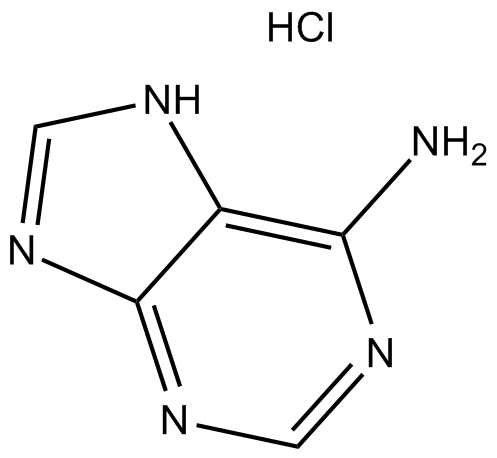Adenine HCl |
| Catalog No.GC11825 |
Adenine HCl (6-Aminopurine hydrochloride), a purine, is one of the four nucleobases in the nucleic acid of DNA. Adenine HCl acts as a chemical component of DNA and RNA. Adenine HCl also plays an important role in biochemistry involved in cellular respiration, the form of both ATP and the cofactors (NAD and FAD), and protein synthesis.
Products are for research use only. Not for human use. We do not sell to patients.

Cas No.: 2922-28-3
Sample solution is provided at 25 µL, 10mM.
IC50: Not available.
Adenine HCl, a purine derivative and a nucleobase, plays crucial roles in substantial biochemistry processes in vivo, including cellular respiration, formation of the energy-rich adenosine triphosphate (ATP), the cofactors nicotinamide adenine dinucleotide (NAD) and flavin adenine dinucleotide (FAD) as well as protein synthesis. In addition, Adenine HCl also serves as a chemical component of DNA and RNA. Adenosine triphosphate is used in cellular metabolism as one of the basic methods of transferring chemical energy between chemical reactions. [1]
In vitro: The cyto-protective effect of Adenosine was measured using an in vitro model of acute tubular necrosis in rat kidney tubular cells. The finding suggested that Adenosine at the concentration of 100 M could significantly decrease cellular injury. The EC50 value of Adenosine was detected to be 14 M. [2]
In vivo: A study was performed to investigate the effects of dietary adenine on fatty liver induced by orotic acid (OA) in rats. 1% OA-supplemented diets with/ without 0.25% adenine was administered to rats for 10 days. Enzyme assay kits were then applied to measure serum lipid profiles of tested rats, such as liver lipid concentrations in different treatment groups. Moreover, the activities of fatty acid synthase (FAS) and fatty acid β-oxidation were also detected. The findings suggested that addition of adenine to the diet offset the effect of OA and reversed promotion of liver TG content to basal level. Administration of Adenine also inhibited FAS activities in rat liver. In conclusion, the ameliorating of fatty liver in adenine-treated rats was associated with the reduction of FAS activities accompanied with the increase of mitochondrial fatty acid β-oxidation and the promotion of serum lipid secretion from the hepatic tissue into the bloodstream. [1]
Clinical trials: So far, no clinical trial has been conducted.
References:
[1]Buang Y. Dietary adenine alleviates fatty liver induced by orotic acid. Indo. J. Chem. 2010; 10 (3): 363 - 369.
[2] Módis K, Ger D, Nagy N, Szoleczky P, Tóth ZD and Szabó C. Cytoprotective effects of adenosine and inosine in an in vitro model of acute tubular necrosis. Br J Pharmacol. 2009 Nov; 158(6): 1565–8.
Average Rating: 5 (Based on Reviews and 1 reference(s) in Google Scholar.)
GLPBIO products are for RESEARCH USE ONLY. Please make sure your review or question is research based.
Required fields are marked with *




















